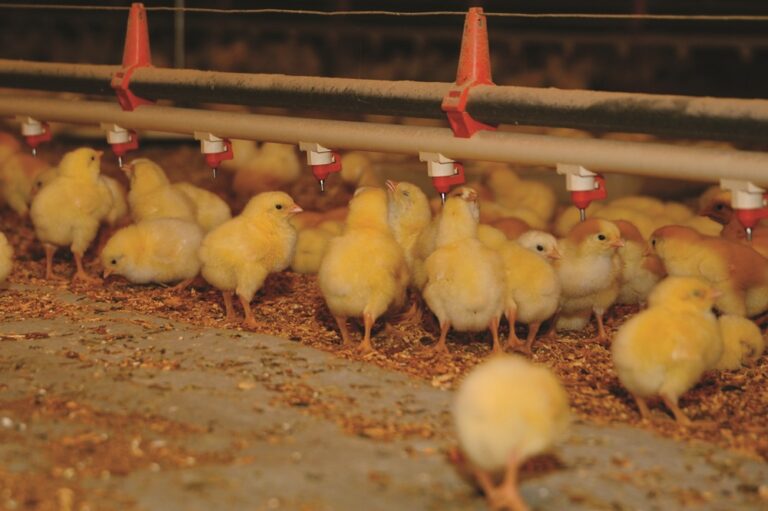It may be a basic requirement, but getting water sanitation fine-tuned on your farm can pay big dividends in bird performance.
By Stuart Thomson, head of sales & technical, Aviagen UK
Water is an essential nutrient for poultry, and the provision of clean water throughout production promotes bird health, welfare and performance. Controlling bacterial contamination and biofilm formation in the drinking system is key to reducing bird exposure to harmful organisms and protecting bird health.
Microbial contamination
While the introduction of enclosed drinking systems, such as nipple lines, has significantly aided water quality, it is important not to forget that water is highly vulnerable to microbial contamination. The water lines that carry water to the birds are not transparent and it is not possible to see the levels of contamination within them. Even water that is of an acceptable quality at source can have significantly higher levels of microbial contamination at the end of the drinker system (Table 1). Controlling the development of this contamination throughout the production period can be achieved through the use of an appropriate water sanitation programme.
Table 1. Aerobic bacteria levels in drip samples
| Farm | At source | At the end of the line |
| A | 2,700 | 26,600 |
| B | 600 | 282,000 |
| C | 0 | 4,775,000 |
Source: Poultry Drinking Water Sanitation: Importance and Options, Maharjan and Watkins, 2016
Water sanitation options
The aim of any water sanitation programme is to create residual protection against recontamination throughout the whole water distribution system and there are a number of water sanitation options available for poultry including ozone, chlorine dioxide, UV light, certain acids and hydrogen peroxide. But chlorination is the most common sanitation methodology used in many countries.
Chlorination is an effective way to achieve water sanitation as it:
- Provides good residual protection against recontamination,
- Uses products that are easily accessible as well as economical,
- Is easy to use and monitor,
- Offers several options for application,
- Promotes good flock health.
To maintain proper sanitation and residual protection from bacterial contamination it is recommended to achieve a chlorine level of 3-5ppm (measured at the end of the drinker line).
When chlorine is added to water at the optimal pH range it forms Hypochlorous acid which is the active sanitising agent. For chlorination to be effective water pH must be between 5 and 7 and an acidifier may need to be added to the water to reduce pH to this level. If water pH is above 7, the production of Hypochlorous acid is reduced and the effectiveness of chlorination is significantly is affected. The choice of acidifier needs careful consideration to avoid any impact on water consumption. Options for acidification include inorganic acids or mixtures of inorganic and organic acids. When using chlorine and acidifiers together they should be added to the water system separately to avoid toxic gas formation.
Other factors that can affect the efficacy of chlorination include:
- Contact time – the time required between injection and water consumption will vary depending on chlorine concentration, type of contaminants, water pH and water temperature,
- Water temperature – a temperature of below 18oC will reduce the effectiveness of chlorination,
- Organic matter – the presence of organic matter can inactivate chlorine,
- Water hardness – the ideal level of scale causing minerals is 0-400ppm,
- Chlorine age and storage – chlorine can be inactivated if stored for too long or stored in transparent containers for too long.
Where chlorination is not permitted, there are other effective water sanitation options (Table 2).
Table 2. Alternative water sanitation methods to chlorination
| Alternative Option | Pros | Cons |
| Hydrogen Peroxide | Has a rapid bacterial action and is effective against a wide range of viruses, yeasts and fungi. Works well to breakdown biofilms and is non-corrosive. | Can be difficult to source and handling requires extreme care. |
| Chlorine dioxide | A good water sanitiser, which can work better than chlorine. Is effective over a wide pH range (4-9). | Has a highly reactive chemical nature and is more expensive than chlorine. If organic load is high, levels required to be effective can affect taste and smell of water. |
| Trichloroisocyanuric acid | Strong disinfectant, used as a chlorinating agent. | Only effective over a narrow pH range. |
| Ozone | Effective against bacteria and viruses. | Provides no residual sanitation. |
| UV light | Effective water sanitiser. | Provides no residual sanitation. |
What is best for your flock?
Within poultry production a range of water sources can be used, but, no matter where it comes from, it is important that the water provided to a flock is free from microbial contamination for flock health and performance, and, ultimately, for food safety. The key to successful water sanitation is to find out what works best for the flock and local circumstances, while always following local legislation: to provide residual disinfection throughout the drinking system, inactivate microbes, control biofilm and neutralise undesired contaminants. This means understanding the sanitising product of choice and how it works and ensuring that conditions are optimal for sanitation.


